Plant Name: Rosa ‘Golden Wings’ (Rosa ‘Golden Wings’)
Plant Family: Rose (Rosaceae)
Article by Janice Tucker
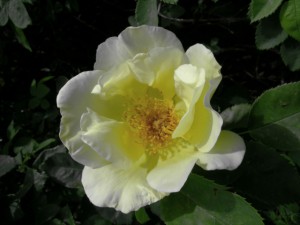
Golden Wing rose closeup (Janice Tucker)
Thank you, Mr. Roy Shepherd for hybridizing the Rosa ‘Souer Thérèse’, Rosa ‘Ormiston Roy’ and Rosa pimpinelifolia that produced the Golden Wings rose cultivar (Rosa ‘Golden Wings’). Introduced to the United States in 1956, the Rosa ‘Golden Wings’ received the American Rose Society Gold Medal in 1958 and went on to win the Royal Horticultural Society Award of Garden Merit in 1993. Its pale yellow petals and dramatic stamens add beauty and grace to any garden.
The Golden Wings rose was hybridized in the United States, but one of its parent plants, Rosa pimpinelifolia, is a species rose native to western, central and south Europe and northwest Africa. The Golden Wings is a shrub rose that can reach a height of 6 feet or more if not pruned back. Four to five slender buds surrounded by dark green, serrated leaves appear at the terminus of thorny stems. This is a single or “almost single” rose with striking, golden yellow stamens radiating from the center of large, pale petals, tinted with a whisper of yellow. Its lightly fragrant flowers are very similar to the lovely, hardy species roses but unlike most of the vintage roses, its blooming period will continue from mid-spring until late summer. It produces large, showy, orange hips that will provide winter color and plenty of vitamin C-laden food for birds.
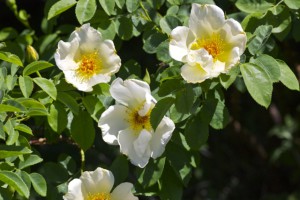
Golden Wings roses and leaves (Janice Tucker)
The Golden Wings rose is a hardy shrub that can be easily propagated from budding, grafting or stem cuttings. It is especially adaptable to the Santa Fe garden. Many new Santa Fe residents are a bit intimidated by the challenges of gardening here. Well, the good news is that growing roses adaptable to our climate is much easier in Santa Fe. We do not have to deal with many of the problems that seem to plague roses elsewhere in the United States. No hazmat suits are necessary to protect us in order to spray and treat our roses with a cocktail of chemicals. Most rose problems in our climate can usually be handled with environmentally acceptable methods. Even then, their care is not terribly demanding. The Golden Wings rose is among the best roses for our environment and a good starter for budding rosarians.
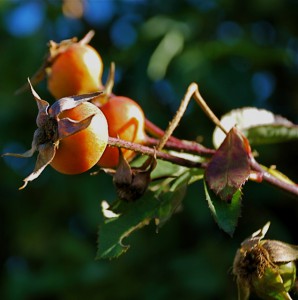
Golden Wings orange rose hips (Janice Tucker)
The Golden Wings rose asks only for a sunny spot, acidic soil with good drainage and deep watering every once in a while. Be sure to water it at the base or by drip irrigation. It does not like overhead, supplemental watering. Since it blooms on new growth, early pruning is recommended – usually in April. Applying a good quality rose fertilizer about 3 times a season will help with the overall health and bloom continuity. Mulching around the base will keep the roots cool during the hot months of June through August and protected from cold in the winter. Deadheading the spent blooms will assure more continuous flowering. Just give it about the same TLC that is normally bestowed on any other plant and the rewards will be a bush full of roses all summer long. In about late August, some gardeners may wish to stop deadheading in order to allow the roses to go to hip. The large hips turn from an apple green to a lovely orange, providing a bright spot of color in the winter flowerbeds.
The light yellow petals of the Golden Wings make this rose an excellent choice for a night garden. As more brilliantly colored flowers fade into the background at sunset, the pale Golden Wings rose remains visible even after nightfall. Under a full moon, it literally glows. It is a very photogenic rose, much to the delight of plant photographers. It can fill many uses in the landscape such as a hedge, a background plant for lower growing plants or as stand- alone shrub.
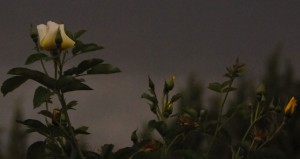
Golden Wings Rose in an evening summer storm by Sonny Tucker.
Mr. Harmon Saville, a renowned rosarian, is credited with stating, “Only the most sophisticated rose growers like singles.” The Golden Wings rose has to be the exception to Mr. Saville’s declaration. Even novices will love this rose. While it is considered a modern rose, it is just about as tough as the species roses. It boasts beautiful, continuous blooms, withstands cold climates, endures the radical swings in temperature from cool nights to warm days and stubbornly resists insects and diseases. What’s not to like?
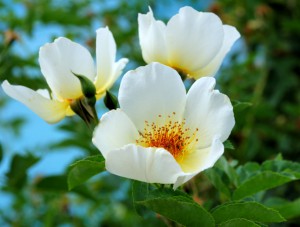
Golden Wings roses (Janice Tucker)


